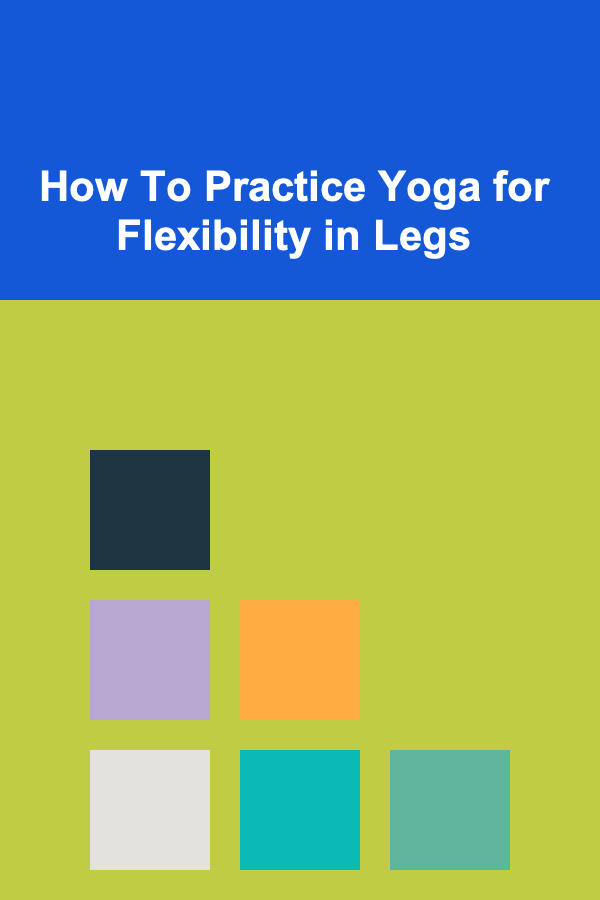
How To Practice Yoga for Flexibility in Legs
ebook include PDF & Audio bundle (Micro Guide)
$12.99$10.99
Limited Time Offer! Order within the next:

Yoga is a powerful practice that combines physical postures, breath control, and mental focus to improve overall health and wellness. One of the most significant benefits that yoga offers is increased flexibility. Whether you're an athlete, a beginner, or someone looking to enhance your mobility, practicing yoga for flexibility in your legs can provide you with a wide range of benefits. Not only will it improve the range of motion in your hips, knees, and ankles, but it will also aid in reducing muscle tension, increasing strength, and preventing injuries.
In this article, we will explore how to practice yoga specifically for leg flexibility, covering essential techniques, postures, and tips to help you achieve your goals in a safe and sustainable way.
Understanding Leg Flexibility
Before diving into specific yoga poses, it's important to understand what leg flexibility entails. The flexibility of the legs refers to the range of motion in the muscles, tendons, and ligaments of the lower body, including the hips, hamstrings, quadriceps, calves, and ankles. Achieving flexibility in these areas not only helps in yoga but also enhances overall posture and mobility in daily activities.
Common challenges faced by those seeking leg flexibility include tight hamstrings, stiff calves, and limited hip mobility. Yoga helps address these issues through a combination of gentle stretching and strengthening exercises, allowing the muscles to release tension and gain more range of motion over time.
Key Muscles Involved in Leg Flexibility
To achieve leg flexibility, it's essential to understand which muscles are involved in movement. These muscles are responsible for both the extension and flexion of the legs, and yoga helps improve their length and elasticity.
- Hamstrings: These are the muscles at the back of your thighs that play a significant role in bending the knee and extending the hip.
- Quadriceps: Located at the front of your thighs, the quadriceps are responsible for straightening your knee and extending your leg.
- Hip Flexors: Located at the front of your hips, the hip flexors help in lifting the leg and bending the knee. Tightness in the hip flexors can restrict flexibility in the legs.
- Calves (Gastrocnemius and Soleus): These muscles are located at the back of the lower leg and play a key role in ankle flexibility and mobility.
- Glutes: The muscles of the buttocks, which are responsible for hip extension, abduction, and rotation.
- Adductors: These muscles run along the inside of the thighs and are responsible for moving the legs together.
The Importance of Warm-up
Before practicing any yoga poses to improve leg flexibility, it's important to warm up your body to prevent injury. A good warm-up prepares your muscles and joints for deeper stretches by increasing blood flow and flexibility. Some simple warm-up techniques include:
- Gentle Flowing Movements: Begin with some simple standing movements like gentle leg swings, standing marches, or light side lunges. These movements will help engage the muscles of the legs, hips, and lower back.
- Dynamic Stretches: Incorporate movements such as forward bends, lunges, and hip circles to mobilize the hips and legs. These dynamic stretches help activate and prepare the muscles for more intensive work.
Remember, the goal of the warm-up is not to force yourself into deep stretches right away, but rather to prepare the body gradually for more intense stretches.
Yoga Poses for Leg Flexibility
Once you've warmed up, you can begin incorporating specific yoga poses to target the legs. These poses will help stretch, lengthen, and strengthen the muscles involved in leg flexibility. Below are several yoga poses that focus on increasing flexibility in the legs.
1. Downward-Facing Dog (Adho Mukha Svanasana)
This iconic yoga pose is a great full-body stretch that particularly targets the hamstrings, calves, and shoulders. The forward bend in the pose helps open up the hips while stretching the legs.
How to Practice:
- Start in a tabletop position (hands and knees on the mat).
- Lift your hips towards the ceiling and straighten your legs, pressing your heels down toward the mat. If your heels don't touch the floor, that's okay---focus on lengthening your spine.
- Keep your head between your arms, aligning your ears with your upper arms.
- Hold for 30 seconds to a minute, breathing deeply as you focus on lengthening the legs and relaxing into the stretch.
2. Standing Forward Fold (Uttanasana)
This forward fold targets the hamstrings and calves, helping to stretch the back of the legs. It also provides a calming effect for the mind, making it an excellent choice for relieving stress while improving flexibility.
How to Practice:
- Stand with your feet hip-width apart and bend forward from the hips, keeping a slight bend in your knees if needed.
- Bring your hands to the floor or hold onto opposite elbows, allowing your head and neck to relax.
- Feel the stretch in the backs of your legs, holding for 30 seconds to a minute.
3. Pyramid Pose (Parsvottanasana)
This pose is excellent for deepening the stretch in your hamstrings and calves while also improving balance. It also stretches the hips and spine.
How to Practice:
- Start in a standing position and step one foot back, keeping your feet about 3 to 4 feet apart.
- Square your hips toward the front leg and fold forward over the extended leg, keeping your spine long and your hands either on the floor or on blocks.
- Hold for 30 seconds to a minute, then switch sides.
4. Low Lunge (Anjaneyasana)
This deep lunge targets the hip flexors and quadriceps, which are often tight due to sitting for long periods. The lunge also opens the chest and stretches the back.
How to Practice:
- Start in a standing position and step one foot back, bending the front knee to 90 degrees.
- Drop the back knee to the floor and lower your hips toward the ground.
- Reach your arms overhead, gently arching your back to deepen the stretch.
- Hold for 30 seconds to a minute, then switch sides.
5. Bridge Pose (Setu Bandhasana)
Bridge pose is an excellent pose for stretching the hip flexors, quads, and hamstrings, while also strengthening the glutes and lower back.
How to Practice:
- Lie on your back with your knees bent and feet flat on the floor, hip-width apart.
- Press your feet into the mat as you lift your hips toward the ceiling, keeping your thighs parallel.
- Interlace your fingers beneath your back or keep your arms by your sides for support.
- Hold for 30 seconds to a minute, focusing on deepening the stretch in your legs.
6. Seated Forward Fold (Paschimottanasana)
This seated pose deeply stretches the hamstrings and calves, while also lengthening the spine. It's an excellent stretch for those who have tightness in the back of the legs.
How to Practice:
- Sit with your legs extended straight in front of you.
- Inhale and lengthen your spine, then slowly fold forward, reaching for your feet or legs. If you can't reach your feet, use a yoga belt or towel around your feet.
- Hold for 30 seconds to a minute, breathing deeply into the stretch.
7. Reclining Hand-to-Big-Toe Pose (Supta Padangusthasana)
This pose is excellent for targeting the hamstrings and calves. It is usually done with a strap to help extend the leg.
How to Practice:
- Lie on your back and extend one leg straight up, holding onto your big toe with your hand (or using a strap around your foot).
- Keep your other leg flat on the floor.
- Hold for 30 seconds to a minute, then switch sides.
Tips for Effective Yoga Practice for Leg Flexibility
To maximize the effectiveness of your yoga practice for leg flexibility, here are some important tips to keep in mind:
- Be Consistent: Flexibility takes time, and progress happens gradually. Practice regularly to see improvements.
- Listen to Your Body: Never push yourself into a painful stretch. Stretch to a point where you feel a gentle pull, not pain. Respect your body's limits.
- Focus on Breath: Deep, steady breathing helps your body relax into the stretch, improving flexibility. Inhale deeply to prepare for a stretch, and exhale as you deepen the stretch.
- Use Props: Blocks, straps, and blankets can help you access deeper stretches without straining.
- Don't Skip the Warm-Up: Warming up your muscles before stretching helps prevent injury and allows you to achieve a deeper, more effective stretch.
- Hold Each Pose Long Enough: To gain flexibility, hold each stretch for at least 30 seconds to a minute. This allows your muscles time to lengthen.
- Mix Stretches with Strengthening: While flexibility is essential, strength is also necessary for balance and stability. Incorporate strengthening poses like Warrior III and Chair Pose into your practice.
Conclusion
Practicing yoga for leg flexibility can significantly improve the range of motion and strength in your legs, hips, and lower body. Whether you're aiming to alleviate tightness, enhance athletic performance, or simply improve your mobility, yoga offers a variety of poses to stretch and lengthen the muscles of the legs.
By staying consistent, listening to your body, and incorporating a combination of dynamic stretches and strengthening poses, you will be well on your way to achieving greater flexibility in your legs. Remember that flexibility is a journey, and the most important thing is to enjoy the process and embrace each step along the way.

How to Create a Family Game Night with Fun Games to Play at Home
Read More
How to Refinance Your Loans for Better Interest Rates
Read More
How to Use Soundproof Paint to Reduce Noise
Read More
How to Winterize Your Home for Energy Efficiency
Read More
How to Give Presentations in a Foreign Language: A Comprehensive Guide
Read More10 Tips for Tracking Rollovers and Transfers in Retirement Accounts
Read MoreOther Products

How to Create a Family Game Night with Fun Games to Play at Home
Read More
How to Refinance Your Loans for Better Interest Rates
Read More
How to Use Soundproof Paint to Reduce Noise
Read More
How to Winterize Your Home for Energy Efficiency
Read More